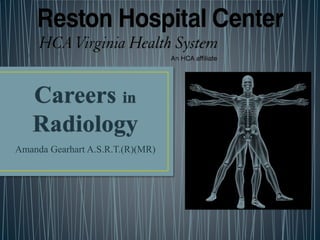Radiology
- 2. ï Radiology PhD ï Radiologist ï MRI Physicist ï Professor of Radiology ï MRI engineering ï Masters in Radiology ï Radiology Assistant ï Healthcare administration ï Bachelorâs in Radiology ï Associates in Radiology
- 3. XRAY Technologist CT Technologist Nuclear Medicine Ultrasound MRI technologist Director of Radiology ïXRAY Technologist US average salary is $51,342 ïCT technologist US average salary is $63,330 ïNuclear Medicine Technologist US average salary is $73,312 ïUltrasound technologist US average salary is $69,633 ïMRI Technologist US average salary is $69,853 ïRadiology Director US average salary id $126,183 Salary.com http://swz.salary.com/
- 4. ïRadiologist US average salary is $380,000 ïMRI Physicist US average salary is $78,374 ïMRI Engineer US average salary is $94,000 ïRadiology Professor US average salary is $207,000 ïNeuroscientist US average salary is $103,000 ï Radiologist ï MRI Physicist ï MRI Engineer ï Radiology Professor ï Neuroscientist Salary.com http://swz.salary.com/
- 5. ï§ XRAY technologist use x-ray equipment to produce 2-D images of the tissue, organs, bones and vessels of the body. ï§ CT Technologist use x-ray equipment to produce 2-D and 3-D images of the tissue, organs, bones and vessels of the body. ï§ Nuclear medicine technologists use radiopharmaceuticals and special cameras to produce images of organs and reveal their function. ï§ Ultrasound technologists use high-frequency sound waves to create images of anatomy. ï§ Magnetic resonance technologists apply a combination of radiofrequency pulses and a powerful magnetic field to create detailed images of anatomy.
- 8. Magnetic resonance imaging (MRI) uses a magnetic field and radio waves to create detailed images of the organs and structures within your body. Health care professionals use MRI scans to diagnose a variety of conditions, from torn ligaments to tumors.








